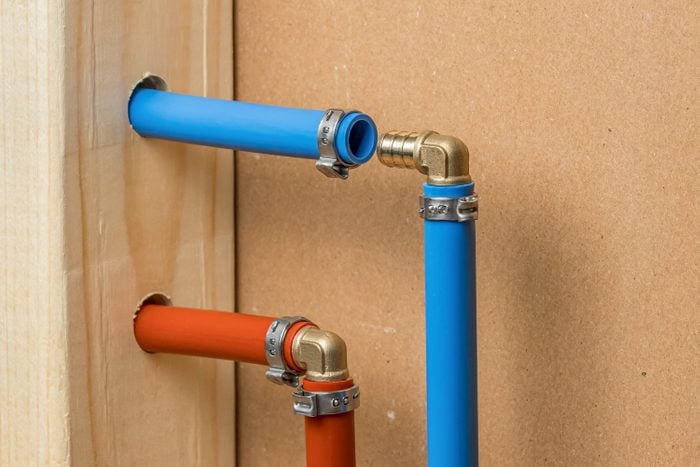What To Know About PEX Pipe Connections
Updated: Mar. 22, 2024

Have a plumbing job coming up? PEX pipe is well worth considering, and learning how PEX connections work is the first step to plumbing success.
Our editors and experts handpick every product we feature. We may earn a commission from your purchases.
When I decided to build my own house from the ground up, I knew some stages of construction would naturally be harder than others. What I didn’t anticipate was how much easier certain jobs were than expected.
One example: Installing my PEX pipe plumbing system.
I originally planned to go with traditional copper water pipes, using my soldering skills to make the necessary connections. I had heard of PEX, but was skeptical of anything plastic lasting long enough to make it worthwhile.
I couldn’t have been more wrong.
Turns out, PEX is extremely durable and way easier to install than copper pipes. The reason boils down to PEX pipe connections. Keep reading and learn everything you need to know about joining PEX pipe.
On This Page
What Is PEX Pipe?
PEX pipe, aka cross-linked polyethylene, is flexible plastic pipe that contains and transports water in plumbing systems. Its popularity among plumbers comes down to a few key advantages over other pipe types: durability, resistance to corrosion and easy installation.
Types of PEX Pipe
@supplyhouse.com #PEX #pexpiping #plumbing #plumberslife #tradeswork #tradesmen #tradeswoman #skilledtrades ♬ ALL INNA DAY – Pretty Beggar
All PEX pipe is made of plastic, with three distinct types of tubing: PEX type A, B and C. Creative name choices, I know. Each type has specific characteristics that help pro plumbers and DIYers decide the best choice for a particular plumbing installation.
PEX type A
The most flexible, PEX type A can be bent and even kinked without losing its structural integrity.
I used type A for my own plumbing system. Although kinks do leave a crease in the pipe, a few careful minutes with a heat gun makes the spot where the kink occurred look like new.
The flexibility lets you put the pipe where you need it without feeling like you’re in a wrestling match. Type A can be joined using a ProPEX expanding tool. More on that later.
PEX type B
Although it’s less flexible than type A, PEX type B offers a good balance between stiffness and flexibility.
Kinks are fixable with type A, but working them out with a heat gun is a pain. They also happened often during my installation thanks to the extra flexibility of type A.
Type B, on the other hand, offers some of the convenience of flexibility without being nearly as vulnerable to kinks. It’s not meant to be joined with a ProPEX expanding tool, relying instead on metal cinching bands to make connections.
PEX type C
The stiffest of the three types, type C is meant for situations where rigidity matters, like radiant heating systems. It’s extremely tough and difficult to kink, and can be joined with a ProPEX expanding tool.
Types of PEX Pipe Connectors
@theplumberlorian Apollo PEX-A expansion 💦 There are many different ways to join pipe in plumbing, in this video I’m going to quickly go over Apollo PEX-A products and how it works. For more products and info check the link in my bio #Sponsored #HomeDepotProTrades #HDSupply #GetCrackin #Plumbing #Plumber #DIY #FYP #ForYou ♬ original sound – The Plumberlorian
As far as I know, there are only two ways of making connections when working with PEX: ProPEX expanding tools and metal cinching bands (aka crimp rings).
ProPEX expanding tools
Made by a handful of manufacturers, ProPEX expanding tools temporarily stretch the ends of PEX, allowing a fitting to be inserted before the pipe’s elasticity closes it again. This tightening down of the PEX over fittings creates a waterproof connection.
ProPEX expanding tools can be hand operated or electric. They work by repeatedly opening a segmented expansion head placed inside the pipe’s end, stretching the pipe open for long enough to make a connection. These tools work with PEX types A and C.
Crimp rings
Used primarily with PEX type B, crimp rings (metal cinching bands) are stainless steel rings compressed over the cut ends of PEX where a fitting connects.
Proper installation requires a special tool called a PEX crimping tool. When you tighten down a crimp ring properly over PEX pipe and the fitting it’s joined to, it creates a water and airtight seal. Trouble is, it’s considerably easier to mess up with crimp rings than with ProPEX expanding tools. And you can’t necessarily see it’s bad until water leaks all over your floor.
Tips for Making PEX Pipe Connections
- Choose the right type of PEX: I personally find type A works best for most residential plumbing situations. If you need something stiffer, consider types B or C.
- Use reinforcing connector rings with your ProPEX expanding tool: These are PEX rings slightly larger diameter than the pipe you’re working with. They fit over the end of the PEX, expanded with the main pipe using the expanding tool. They offer a tighter, stronger connection than the pipe alone. Although skipping them may be tempting, don’t.
- Make square cuts: Your PEX connections will work a lot better if every cut is clean and square. Use a PEX cutting tool to ensure this.
- Check for leaks: Even if you’re confident all your connections are sound, check your installation for leaks before trusting it fully. Doing so could easily save you a whole lot of trouble.
